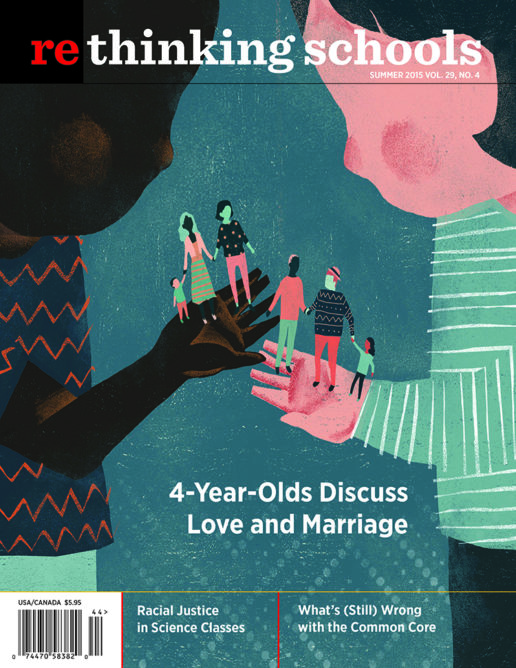Letters 29.4
Unfair to Behaviorists?
The author of “They Deserve Good Teaching, Too: Social Justice in a Classroom for Students with Autism” (spring 2015) has misrepresented to your readership what Applied Behavior Analysis (ABA) is in its current best practices. The author’s experience was not in a clinically overseen context but in a school program, which is often an incomplete application of ABA teaching methods. A quality ABA program focuses on a child’s individual interests and strengths. It uses motivators within the work, extrinsic rewards, and social praise. The ultimate goal is to reduce the feel of a discrete trial until it is natural involvement in the classroom.
As the mother of a child with moderate autism spectral disorder, I am eternally grateful to the psychologists who developed and are keeping current the science of ABA. Without it (and the guidance of a licensed and experienced center-based program) I would not have had a way to give him the building blocks of language, learning, and behavior. He would still, at age 11, be slowly, “naturally” learning these things (most likely in a self-contained classroom) instead of being fully included in his general education classroom.
Carli Hildebrandt
Ann Arbor, Michigan
Leanna Carollo responds:
In my article, I described my experience of working in a school designed specifically for students with severe autism and centered on research-based ABA practices. The school has a partnership with a local research hospital. Certified psychologists, therapists, and special education teachers are part of the school team, where they receive additional training and instruction. The lesson plans used by the school are created from students’ IEPs. Although students’ interests and preferences were used as motivators, at this school site, their interests were not incorporated into the lessons themselves.
I wanted to use students’ interests and to give them voice in the classroom, which I did not see occurring otherwise during my time working there. As an educator, I felt obligated to help my students move beyond extrinsic rewards and to feel internally motivated and empowered to be successful. When I adjusted lessons to their preferences and likes, I found that there was not a significant need for external motivators. Similarly, when students were listened to and were given opportunities to express their feelings, I found that the occurrence of aggressive behavior decreased significantly.
I completely agree that a quality educational program incorporates students’ interests and background knowledge. I also feel that student choice and voice are essential components of quality education.
I am so glad to know that your son was exposed to teaching practices that have resulted in his success. Perhaps this conversation is a great reminder for all educational programs not to underestimate the importance of student voice and interests in educational settings.
Censorship vs. Climate
I appreciated the article “Teaching the N-Word” (fall 2014). Michelle Kenney addresses a very sensitive issue in what I found to be an overall thoughtful manner. She created a safe environment in which her students felt comfortable engaging in a productive dialogue about an important topic. I respect her decision to ask her students not to read the n-word out loud during their study of Fences in the interest of maintaining that safe environment.
However, I was disappointed that the article lacked a discussion of censorship beyond a brief comment in relation to rap music. Specifically, the article does not address the possible implications of censoring a piece of literature such as Fences. The students in this article discuss the ways that intent may affect the use of the n-word; I was surprised that August Wilson’s authorial intent in using this word was not discussed as well. I would have liked the article to focus more on how that censorship might alter Wilson’s playwriting style and the overall reading of the play.
Keira Hamilton
English education student at San Francisco State University
Michelle Kenney responds:
Keira Hamilton brings up valid points about the need to discuss censorship and the use of the n-word in August Wilson’s work.
I usually cover the topic of censorship at the beginning of the school year. By the time we begin Fences, my students are comfortable discussing the motives and consequences of banning books. We also discuss the impact of banning specific words, such as some publishers’ current practice of replacing the n-word in Huckleberry Finn with slave.
However, I never suggested that Wilson should not have used the n-word, so I don’t see how a similar discussion of the way censorship would affect his style is necessary. In fact, I made it clear that it is very important for students to see, read, and even hear the word in an historical context. How else can they understand the history of racism and resistance in the United States? Although we develop norms around not reading the word out loud in class, students do see it, read it, and view scenes. Also, once we begin the play, we spend a considerable amount of time having the discussions you suggested about Wilson’s reasons for using the n-word, something that the essay and debate have prepared them to do in a safe and constructive way. I didn’t include these lessons and discussions in “Teaching the N-Word” because the article describes a pre-reading activity I use to build background knowledge and create norms.

